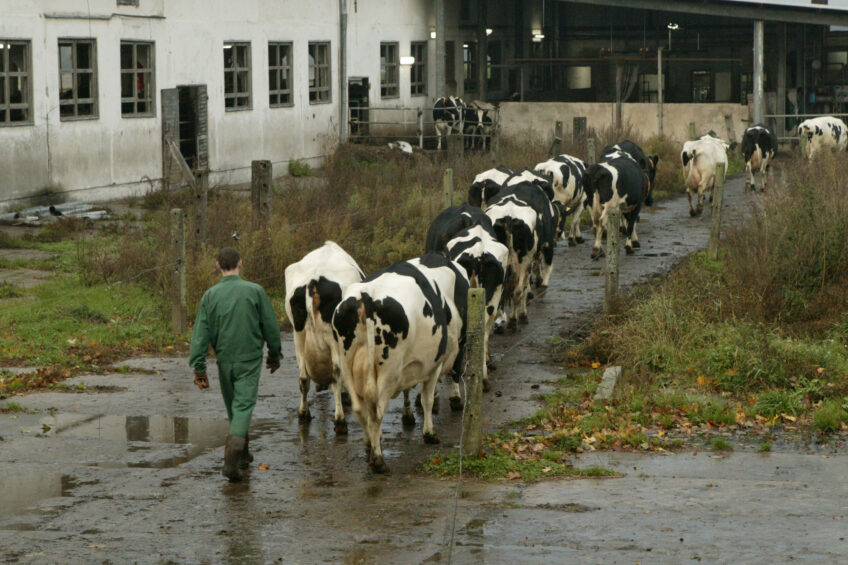Polish dairy sector back in business

The 2015 dairy crisis is gone and forgotten, according to milk producers and processors in Poland. The Polish dairy sector has been flourishing this year, although new challenges are around the corner.
Poland is the 4th biggest milk producer in the European Union, and it looks like Poland is rebuilding its dairy sector after the dairy crisis a few years ago. Farmers are expanding their farms and export is booming. “I hope we can keep this positive vibe for a while, says Andrzej Grabowski, co-owner of Polmlek, a company that launched one of the largest dairy factories in Europe just recently and saw revenue increase by 14% last year. Also other dairy processors are doing well and are able to invest again. For example, Mlekovita, Central and Eastern Europe’s largest dairy group, had over PLN 4 billion (over € 1 billion) revenue last year. Mlekpol showed a revenue of PLN 3.2 billion (€ 0.76 billion). Polmlek comes in third with PLN 888 million (€ 211 million).
Dairy consumption on the rise
Also Polish farmers have reasons to be happy. They received PLN 130 to 135 (€ 30.65 to € 31.83) per 100 kg of milk last year. Compared to the PLN 80 (€ 18.86) during the dairy crisis, this is a huge improvement. Also milk consumption is on the rise in Poland. In 2016, consumption of all dairy products in Poland increased by 4.5%, reaching 219 litres of milk per person. Especially the consumption of yoghurt, aged cheese, processed cheese, milk desserts and cream cheese is growing. Farmers produce around 30% more milk than the domestic consumption. The Polish dairy sector is therefore forced to export the surplus in the form of milk powder, butter and cheese. “Export of Polish dairy products in Q1 2017 increased by 36% compared to the same period in 2016, explains Marcin Hydzik, president of the Polish Milk Processors Association. “The Polish dairy sector keeps on growing and it is estimated that by the end of 2017 production will reach 11 billion litres of milk, hence a significant increase in export.”

Polish products not in all EU shops
Although production and exports are flourishing, Polish dairy farmers still see room for improvement. Dairy producers have been complaining for a long time that their products are not available in supermarkets in Germany or France.
Against EU law
“They won’t let us enter the European market on purpose and they don’t mind that what they’re doing is against the European Union law,” says Lech Karendys, sales director at the dairy cooperative Mlekpol. According to Karendys there are many examples that reflect the problem. “One of the supermarket chains told us recently that private label products intended for the French market can only be made with French milk. This doesn’t make any sense, our milk is no different than the French milk. The large retail chains just decide on their own which products their domestic consumers can buy. The local lobby prevents us from accessing these markets.”
Nevertheless, the Polish dairy products are also increasingly exported to countries outside the European Union.
“Currently, we are shipping products to 100 countries outside the EU. We have the capacity to conquer new markets, for example Latin America,” says Agnieszka Maliszewska, director of the Polish Chamber of Milk. Edward Bajko, president of the dairy cooperative Spomlek confirms: “We have customers across the world. Our products are even sent to Cuba and Asia.” The main export products include easily stored powder products, such as milk powder, whey powder, as well as aged cheese and butter. Cheeses, in particular aged, fresh and cottage cheese, are of particular importance. Processed cheese is less popular. China is the biggest importer of Polish milk products. According to CLAL statistics, Chinese import increased in 2016 by over 20%. Another important destination for milk products export is Central and Eastern Europe, including Lithuania, Latvia and Estonia. As a result of the Russian embargo, exports to Belarus, Armenia and Ukraine have increased as well.
GMO feed ban
But new challenges arise for Polish farmers. In the last couple of months, there have been active discussions in Poland about GMO feed for cows. Officially, in Poland there is no ban on GMO-feed, although a moratorium will officially come into force in 2019. Regardless of the moratorium, many Polish dairies started to enforce a ban on milk from GMO-fed cows. For example, the dairy processor Hochland dairy enforced such a ban on their supplying farmers and soon the dairy firm Spomlek will follow. Suppliers of leading milk cooperatives Mlekpol and Ryki are now preparing such a ban as well. Agnieszka Kamela, director of raw material acquisition at Spomlek explains why they don’t want to wait until 2019. “GMO improves plants’ resistance ensuring better yield and enables plants to be grown outside of their natural climate zones. However, safety of our customers is our priority, and still there is no 100% certainty that GMO consumption has no negative impacts on human health.” What do the dairy farmers think of all this? Mateusz Darkowski, produced 13,700 kg with his 100 cows and delivers to Hochland. “At the very beginning we were very sceptical about the decision. Everyone who disagreed with the switch of feed had to go to another dairy. I believe it was at least one person in 6 who decided to do so. Contrary to what most farmers say, I think Hochland made the right decision, that will pay off in the future. We will not ignore the non-GMO discussions, so we followed.” Hochland’s suppliers started their transitional period on 1 January and switched exclusively to GMO-free feed as of 1 April this year.
Premium milk price
Due to the high yield of his cows, farmer Darkowski decided to replace post-extraction soya meal with a non-GMO soybean meal. His herd consumes 200 kg of meal per day, which means 6 tonnes per month. Assuming that non-GMO feed costs PLN 500 (€ 119) more per tonne, he pays PLN 3,000 (€ 714) more for the feed. Luckily, following the enforced change of feed, the dairy company offered him a raise of PLN 0.08 (€ 0.02) per litre of milk. He now gets PLN 1.43 (€ 0.34) per litre. However, farmers from other regions of Poland sometimes get more, up to PLN 1.61 (€ 0.38) per litre of non-GMO milk. Nevertheless, farmers are not afraid of losing profitability. They are more concerned about the administration involved when using non-GMO feed. “Over the last few months I had to keep track of more invoices and certificates than before. I am also required to record my feed supplies. But the extra work is compensated by the relatively good price of milk,” says dairy farmer Dawid Kozłowski from Długołęka in the Zachodniopomorskie Region. The question is whether more non-GMO milk on the Polish market will also boost domestic consumption of dairy products. According to experts, this will certainly be the case, “As much as 80% of the public is against GMO food, so there should be a positive response,” says Agnieszka Kamela, director of Milk Acquisition at Spomlek. However, the effects will only be visible after some time, at least one year.” At the same time, dairy firms are not shouting from the rooftops that they are starting to produce GMO-free milk. Not even one Polish dairy farm has organised a large-scale promotional campaign on GMO-free products. But this will probably change in the near future.
Join 13,000+ subscribers
Subscribe to our newsletter to stay updated about all the need-to-know content in the dairy sector, two times a week.










